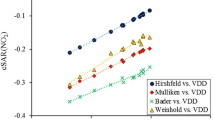Abstract
The theoretical calculation of the charge mobility of 2,5-bis(trialkylsilylethynyl)-1,1,3,4-tetraphenylsiloles is presented. B3LYP/6-31* calculations demonstrated that these silole molecules possessed large coupling matrix elements and reorganization energies for electron and hole transfers and high electron mobilities. The bulkiness of the trialkyl substituents influenced the charge mobility of the silole molecules, with the smaller trimethyl group imparting higher charge mobility than triethyl and triisopropyl substituents.
Similar content being viewed by others
References
Khabashesku VN, Balaji V, Boganov SE, Nefedov OM, Michl J. Matrix isolation of silacyclopentadienes: UV-visible and IR spectra and photochemical interconversion. J Am Chem Soc, 1994, 116: 320–329
Yamaguchi S, Tamao K. Silole-containing σ- and π-conjugated compounds. J Chem Soc Dalton Trans, 1998, 3693–3702
Mäkinen AJ, Uchida M, Kafafi ZH. Electronic structure of a silole derivative-magnesium thin film interface. J Appl Phys, 2004, 95: 2832–2838
Murata H, Kafafi ZH, Uchida M. Efficient organic light-emitting diodes with undoped active layers based on silole derivatives Appl Phys Lett, 2002, 80: 189–191
Tang BZ, Zhan X, Yu G, Lee PPS, Liu Y, Zhu D. Efficient blue emission from siloles. J Mater Chem, 2001, 11: 2974–2978
Zhao Z, Chen S, Lam JWY, Jim CKW, Chan CYK, Wang Z, Lu P, Kwok HS, Ma Y, Tang BZ. Steric hindrance, electronic communication, and energy transfer in the photo- and electroluminescence processes of aggregation-induced emission luminogens. J Phys Chem C, 2010, 114: 7963–7972
Chen HY, Lam JW, Luo JD, Ho YL, Tang BZ, Zhu D, Wong M, Kwok HS. Highly efficient organic light-emitting diodes with a silole-based compound. Appl Phys Lett, 2002, 81: 574–576
Usta H, Lu G, Facchetti A, Marks TJ. Dithienosilole- and dibenzosilole-thiophene copolymers as semiconductors for organic thin-film transistors. J Am Chem Soc, 2006, 128: 9034–9035
Dong YQ, Lam JWY, Qin AJ, Li Z, Liu JZ, Sun JZ, Dong YP, Tang BZ. Endowing hexaphenylsilole with chemical sensory and biological probing properties by attaching amino pendants to the silolyl core. Chem Phys Lett, 2007, 446: 124–127
Peng L, Wang M, Zhang G, Zhang D, Zhu D. A fluorescence turn-on detection of cyanide in aqueous solution based on the aggregation-induced emission. Org Lett, 2009, 11: 1943–1946
Yu Y, Hong Y, Feng C, Liu J, Lam JWY, Faisal M, Ng KM, Luo KQ, Tang BZ. Synthesis of an AIE-active fluorogen and its application in cell imaging. Sci Chin Ser B Chem, 2009, 52: 15–19
Mi B, Dong Y, Li Z, Lam JWY, Häußler M, Sung HHY, Kwok HS, Dong Y, Williams ID, Liu Y, Luo Y, Shuai Z, Zhu D, Tang BZ. Making silole photovoltaically active by attaching carbazolyl donor groups to the silolyl acceptor core. Chem Commun, 2005, 3583–3585
Yamaguchi S, Endo T, Uchida M, Izumizawa T, Furukawa K, Tamao K. Toward new materials for organic electroluminescent devices: synthesis, structures, and properties of a series of 2,5-diaryl-3,4-diphenylsiloles. Chem Eur J, 2000, 6: 1683–1692
Luo JD, Xie ZL, Lam JWY, Cheng L, Chen HY, Qiu CF, Kwok HS, Zhan XW, Liu YQ, Zhu DB, Tang BZ. Aggregation-induced emission of 1-methyl-1,2,3,4,5-pentaphenylsilole. Chem Commun, 2001, 1740–1741
Zhao Z, Chen S, Shen X, Mahtab F, Yu Y, Lu P, Lam JWY, Kwok HS, Tang BZ. Aggregation-induced emission, self-assembly, and electroluminescence of 4,4′-bis(1,2,2-triphenylvinyl)biphenyl. Chem Commun, 2010, 46: 686–688
Hong Y, Lam JWY, Tang BZ. Aggregation-induced emission: Phenomenon, mechanism and applications. Chem Commun, 2009, 4332–4353
Liu J, Lam JWY, Tang BZ. Aggregation-induced emission of silole molecules and polymers: Fundamental and applications. J Inorg Organomet Polym, 2009, 19: 249–285
Zhao Z, Chen S, Lam JWY, Chan CYK, Jim CKW, Wang Z, Wang C, Lu P, Kwok HS, Ma Y, Tang BZ. Luminescent tetraphenylethene-substituted silanes. Pure Appl Chem, 2010, 82: 863–870
Li Z, Dong Y, Lam JWY, Sun J, Qin A, Häußler M, Dong Y, Sung HHY, Williams ID, Kwok HS, Tang BZ. Functionalized siloles: Versatile synthesis, aggregation-induced emission, and sensory and device applications. Adv Funct Mater. 2009, 19: 1–13
Zhao Z, Chen S, Lam JWY, Lu P, Zhong Y, Wong K, Kwok HS, Tang BZ. Creation of highly efficient solid emitter by decorating pyrene core with AIE-active tetraphenylethene peripheries. Chem Commun, 2010, 46: 2221–2223
Zhao Z, Wang Z, Lu P, Chan CYK, Liu D, Lam JWY, Sung HHY, Williams ID, Ma Y, Tang BZ. Structural modulation of solid-state emission of 2,5-bis(trialkylsilylethynyl)-3,4-diphenylsiloles. Angew Chem Int Ed, 2009, 48: 7608–7611
Yu G, Yin SW, Liu YQ, Chen JS, Xu XJ, Sun XB, Ma DG, Zhan XW, Peng Q, Shuai ZG, Tang BZ, Zhu DB, Fang WH, Luo Y. Structures, electronic states, photoluminescence, and carrier transport properties of 1,1-disubstituted 2,3,4,5-tetraphenylsiloles. J Am Chem Soc, 2005, 127: 6335–6346
Risko C, Kushto G P, Kafafi Z H, Brédas J L. Electronic properties of silole-based organic semiconductors. J Chem Phys, 2004, 121: 9031–9038
Zhan X, Risko C, Korlyukov A, Sena F, Timofeeva TV, Antipin MY, Barlow S, Brédas JL, Marder SR. Comparative studies of the geometric and electronic properties of 1,1-disubstituted-2,3,4,5-tetraphenylsiloles and 1,1,2,2-tetramethyl-3,4,5,6-tetraphenyl-1,2-disila-3,5-cyclohexadiene. J Mater Chem, 2006, 16: 3814–3822
Marcus R A. Electron transfer reactions in chemistry. Theory and experiment. Rev Mod Phys, 993, 65: 599–610
Marcus RA, Eyring H. Chemical and electrochemical electron-transfer theory. Annu Rev Phys Chem, 1964, 15: 155–196
Author information
Authors and Affiliations
Corresponding authors
Rights and permissions
About this article
Cite this article
Zhao, Z., Liu, D., Lam, J.W.Y. et al. Theoretical study of substituent effect on the charge mobility of 2,5-bis(trialkylsilylethynyl)-1,1,3,4-tetraphenylsiloles. Sci. China Chem. 53, 2311–2317 (2010). https://doi.org/10.1007/s11426-010-4079-8
Received:
Accepted:
Published:
Issue Date:
DOI: https://doi.org/10.1007/s11426-010-4079-8




